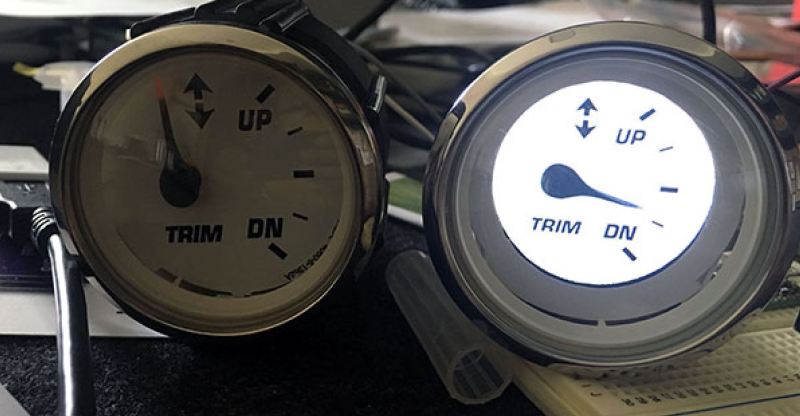The odds are that many of you do not own a boat that you get to tinker around with. [Mavromatic] recently acquired one that had — much to his consternation — analog gauges. So in order to get his ship ship-shape, he built himself a custom digital gauge to monitor his vessel’s data.
Restricted to the two-inch hole in his boat’s helm, trawling the web for displays turned up a 1.38-inch LCD display from 4D Systems. Given the confined space, a Teensy 3.2 proved to be trim enough to fit inside the confined space alongside a custom circuit board — the latter of which includes some backup circuits if [mavromatic] ever wanted to revert to an analog gauge.
Two days of acclimatization to the display’s IDE and he had enough code to produce a functional display right when the parts arrived.
The screen is housed in a blank gauge that required careful breaking into, and — in a stroke of genius — the chrome rim proved to be fortuitous capacitance sensor that swaps between the various information screens at a tap of the bezel.
[mavromatic] had originally wanted to install a fish-finder and chartplotter that could also display the engine data he wanted, but that proved to be complicated to the point of a fruitless hassle. Naturally, his maker proclivities made designing a custom gauge to display what he wanted from the vessel’s NEMA 2000 grid the more inspiring project.
Do you too share that love for sailing forbidden seas but can’t drop the dough on a new boat? You can start by building a personal watercraft — sometimes for naught but a pittance.
















Why is this not a commercial product :( stunning.
Why are car infotainment systems standard in many new cars then?
A ‘car infotainment system’ is a valid example of keeping thing simple?
This is an example of what’s wrong with lots of hackers’ “hacker mentality”.
”Simplicity is a great virtue but it requires hard work to achieve it and education to appreciate it. And to make matters worse: complexity sells better” – Edsger W. Dijkstra
“Simplicity is the ultimate sophistication” - Leonardo da Vinci
I think you read that wrong… Nicholas was asking why the car systems are standard if the reason not to have commercial versions of this fancy electronic display is keeping things simple.
This is nice, but it’s a $70 display, which is a bit expensive for a bit of hobby tinkering. For a $$$$$ boat, sure :D.
Oooh, those would be great for flightsim gauges too. At $70 a pop though, that could add up quick.
Very nice! Now you can install different skins like on a smartwatch :P
@James Hobson – “to display what he wanted from the vessel’s NEMA 2000 grid the more inspiring project.”
It’s NMEA, the National Marine Electronics Association, not NEMA, the National Electrical Manufacturers Association.
It would be interesting to hear how well this holds up to real world conditions. I know when we go out to deep water +50mi on even a semi-rough day the beating can be quite “uncomfortable”
Ill be curious to see how well that capacitive touch works in the rain/wet that most boats experience.
This is an extension of the logic that that was used to buy Manhattan from the Indians.
An LCD attempt to replace a physical dial is a bad idea IMO. The LCD will not hold-up over time, especially in an constant outdoor-exposure environment, like a small boat. I think a better approach might be re-purposing existing (and inexpensive) small dashboard stepper-motor indicators. The steppers are small enough to adapt to the original indicator, and you can make a new calibrated dial-card using a home printer (be careful with ink and paper/film selection, again for longevity in direct sunlight).
Or he could have just used his microprocessor to generate the analog signal the stock gauge was looking for, and continued to use that gauge. The whole point is he wanted a digital gauge, usability or reliability be damned.
PS – it is a OLED panel not LCD. Even harder to read in direct sunlight
Hi! Yes, all great points and I’ve considered them all — heat, sunlight, weather, etc. all are potential known issues given the environment and typically why bother with “electronics” — but where’s the fun being practical. Although, the PCB I designed can also be used with the original analog trim gauge to translate the digital NMEA Engine Trim data to the Analog Gauge… that is my fall back — time will tell.
Also, the boat is a cabin cruiser so the helm is somewhat protected from the elements and I use the boat is used on a lake with an occasional outing in the Puget Sound.
Today, I plugged everything in and tested — so far so good — just need to make a few adjustments. One of my temp sensors while NMEA2K use a proprietary Lowrance PGN so the library I’m using isn’t getting that data… working on getting that data read by the Teensy.
I hope to have everything installed by weeks end and then I’ll take more photos and videos to share.
I’m disappointed. No Raspberry Pi.
I wonder how hackable those cheap chinese oled/lcd watch displays are?
looks fun but sometimes, a gauge that can handle saltwater submersion and cold temperatures for decades and frees up with a sharp thwack is the superior solution.